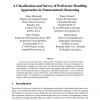Free Online Productivity Tools
i2Speak
i2Symbol
i2OCR
iTex2Img
iWeb2Print
iWeb2Shot
i2Type
iPdf2Split
iPdf2Merge
i2Bopomofo
i2Arabic
i2Style
i2Image
i2PDF
iLatex2Rtf
Sci2ools
CI
2004
2004
A Classification and Survey of Preference Handling Approaches in Nonmonotonic Reasoning
In recent years, there has been a large amount of disparate work concerning the representation and reasoning with qualitative preferential information by means of approaches to nonmonotonic reasoning. Given the variety of underlying systems, assumptions, motivations, and intuitions, it is difficult to compare or relate one approach with another. Here, we present an overview and classification for approaches to dealing with preference. A set of criteria for classifying approaches is given, followed by a set of desiderata that an approach might be expected to satisfy. A comprehensive set of approaches is subsequently given and classified with respect to these sets of underlying principles.
| Added | 16 Dec 2010 |
| Updated | 16 Dec 2010 |
| Type | Journal |
| Year | 2004 |
| Where | CI |
| Authors | James P. Delgrande, Torsten Schaub, Hans Tompits, Kewen Wang |
Comments (0)

